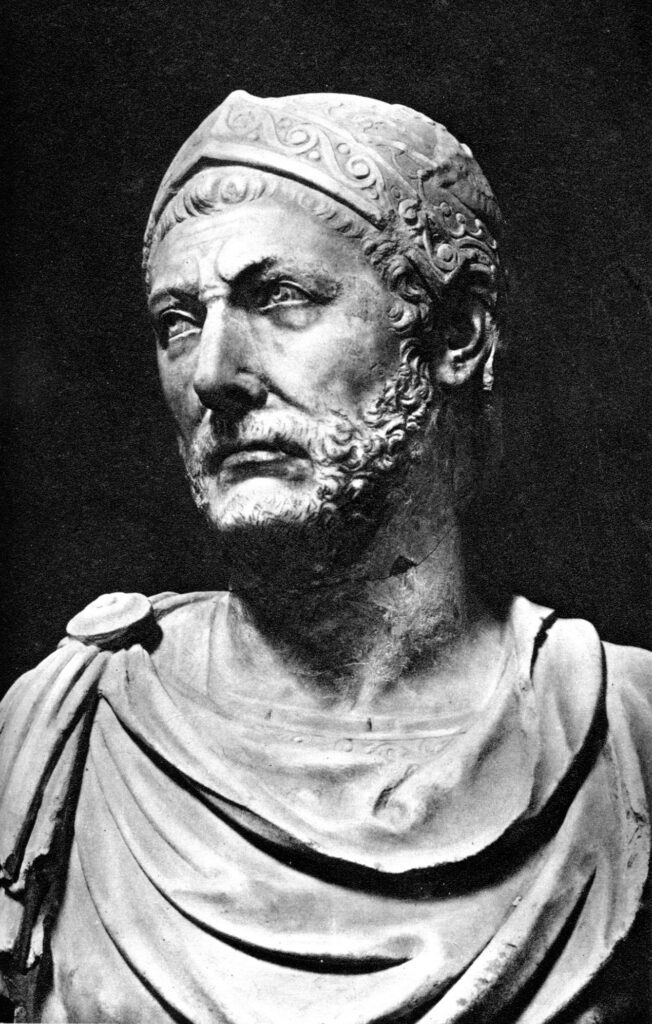Hannibal Barca, the Carthaginian general, is renowned for his military genius and audacious tactics during the Second Punic War. Born in Carthage in 247 BC, he received an exceptional education in military strategy and the art of war. Hannibal’s most famous victory was the Battle of Cannae, where he employed a brilliant strategy of encircling and crushing the much larger Roman army. Another notable tactic was his decision to march his army, including elephants, across the treacherous Alps to surprise attack Rome. Hannibal’s strategic brilliance was further showcased in battles such as Lake Trasimene and Trebbia. Although he did not achieve his ultimate goal of defeating Rome completely, Hannibal’s legacy as a symbol of strategic genius and innovation lingers on. His tactics continue to be studied and admired by military leaders and historians alike.
The Brilliant Tactics of Hannibal Barca: Carthage’s Fearsome General
Introduction
Hannibal Barca, the brilliant Carthaginian general, is widely regarded as one of the greatest military strategists in history. He is known for his audacious tactics during the Second Punic War, where he brought the mighty Roman Republic to its knees. Hannibal’s genius on the battlefield and his ability to outmaneuver and outwit his opponents have earned him a prominent place in military history.
Early Life and Education
Hannibal Barca was born in 247 BC in Carthage, a city-state located in modern-day Tunisia. He belonged to the Barcid family, a prominent Carthaginian clan known for its military prowess. As a child, Hannibal received a privileged education, learning about military strategy, tactics, and the art of war.
The Battle of Cannae
One of Hannibal’s most famous victories was the Battle of Cannae in 216 BC. Facing a Roman force twice the size of his own, Hannibal employed a brilliant strategy that is still studied in military academies today. He positioned his troops in a concave formation, allowing the Roman army to advance and envelop his flanks. Once the Roman forces were tightly packed, Hannibal ordered his cavalry to charge from the rear, effectively encircling and crushing the enemy. This victory resulted in the death of over 50,000 Roman soldiers and is considered one of the most significant military achievements in history.
The Alpine Crossing
One of Hannibal’s most daring tactics was his decision to march his army, including elephants, across the treacherous Alps to attack Rome. This strategic move caught the Romans off guard, as they did not anticipate an attack from the north. Despite the harsh conditions and losses suffered during the crossing, Hannibal successfully deployed his forces in Italy, effectively outmaneuvering his opponents and securing several military victories.
The Battle of Lake Trasimene
In 217 BC, Hannibal orchestrated an ambush at Lake Trasimene, catching the Romans by surprise. He positioned his troops in a valley, while the Romans marched along the lakeshore, unaware of their impending doom. As the Roman army advanced, Hannibal’s forces sprung the trap, attacking from all sides. The Romans were decimated, with thousands losing their lives, including the Roman consul himself. This battle showcased Hannibal’s ability to capitalize on the element of surprise and exploit the terrain to his advantage.
The Battle of Trebbia
The Battle of Trebbia, fought in 218 BC, demonstrated Hannibal’s strategic brilliance once again. Facing a Roman force led by the consul Tiberius Sempronius Longus, Hannibal employed a tactic called the pincer movement. He split his forces into three parts, with the center advancing while the wings remained hidden. Once the Romans engaged the center, Hannibal ordered his wings to attack from the sides, effectively trapping the enemy between his forces. This maneuver resulted in a crushing defeat for the Romans, further solidifying Hannibal’s reputation as a master tactician.
The Legacy of Hannibal Barca
Despite his impressive victories and tactical brilliance, Hannibal was never able to achieve his ultimate goal of defeating Rome completely. The Roman resilience and the lack of support from Carthage prevented him from a complete military conquest. However, Hannibal’s legacy endures as a symbol of strategic genius and the application of unconventional warfare. His tactics continue to be studied by military leaders and historians, serving as a timeless reminder of the importance of well-executed strategy and the ability to adapt and innovate in the face of daunting odds.
Conclusion
Hannibal Barca’s military brilliance and tactical genius have left an indelible mark on history. His audacious and innovative strategies enabled him to achieve remarkable victories over the mighty Roman Republic. Although ultimately unsuccessful in his campaign against Rome, Hannibal’s unmatched tactical skills and battlefield prowess continue to inspire and captivate military leaders and scholars to this day.
